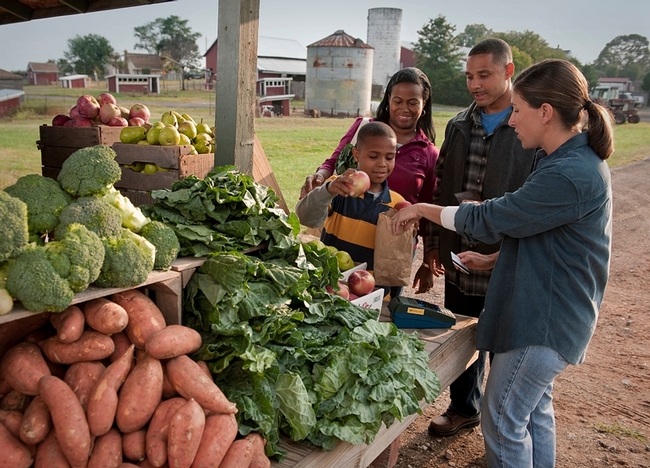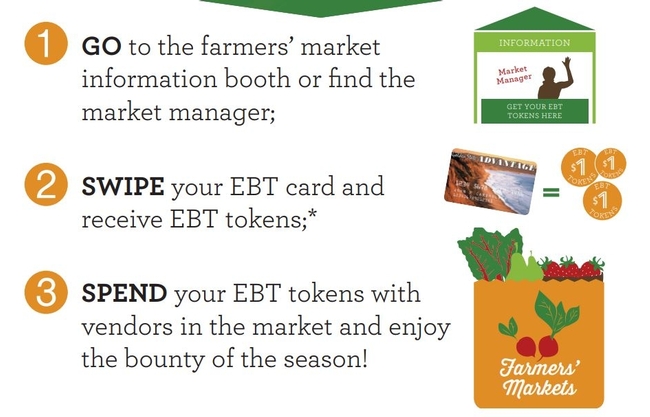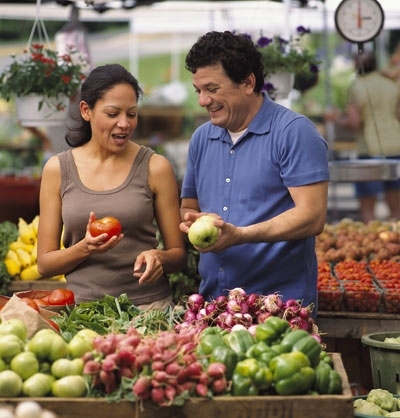Across the United States, land use policies and institutional discrimination have had major implications for the production and distribution of our food and has shaped and continue to reinforce inequitable access to food and food production. As a result, today “white, non-Hispanic and male farmers own more land and generate more farm-related wealth than farmers of color, with Hispanic ethnicity, and females.” While the profit from food production has become concentrated in the hands of a few, typically white, male farm owners, there is evidence that farmworkers lack access to the very goods they labor to bring to market. Indeed, five of the eight lowest paying jobs in the U.S. are in our food system and nearly 75% of farmworkers earn less than $10,000 per year.
At the same time, the popularity and number of farmers markets across the U.S. has grown rapidly in the last decade from a total of 4,685 registered markets in 2008 to 8,687 in 2017. Farmers markets can enhance community health through access to fresh fruits and vegetables, increase social cohesion, and support local farmers and economies. Still there is evidence that not everyone has access to their local farmers markets or feels welcomed in these environments. In particular, low-income consumers and consumers from communities of color may be less likely to shop at farmers markets in some locations if they do not feel welcome due to cultural or language barriers.
There is potential for farmers markets to be spaces for increasing equitable access to local fresh fruits and vegetables, particularly in areas where residents do not have access to full-service grocery stores. One promising practice in increasing access to farmers markets among low-income shoppers is the acceptance of CalFresh (food stamps, EBT). In a few studies, researchers have noted that consumers report that acceptance of CalFresh benefits is a facilitating factor in their decision to shop at a farmers market and that the lack of ability to pay with their CalFresh card is a barrier.
In addition, incentives for low-income consumers have started to become more widely available to CalFresh beneficiaries that choose to shop at the local farmers market. In California, this program is most commonly referred to as Market Match. Market Match on a local level is administered by farmers markets and can double the amount of money CalFresh beneficiaries have to spend on fresh fruits and vegetables at the participating farmers market.
While the purpose of these incentive programs is to increase access to fresh, local produce in low-income communities, the program is not always well-known or easily accessed by eligible consumers. Additionally, market managers often face large administrative burdens to offer the benefit to shoppers and, especially at smaller markets, may not see the economic benefit of the program for years.
Added to these challenges, the funding sources for incentive programs vary by farmers market, as do foods that can be purchased with the incentives, often leading to confusion for consumers and farmers, as well as increasing administrative burdens for market managers. For example, shoppers receive different types of tokens (one for CalFresh benefits and another for the Market Match) that can only be used on certain products. These differences can be confusing to consumers who need to navigate the programs' restrictions to determine which food items they can purchase. For example, can CalFresh tokens be used on bread? Or, can Market Match tokens only be used to purchase fruits or vegetables?
Even prior to utilizing these programs, many low-income California residents face difficulties applying for and obtaining CalFresh benefits (known nationally as SNAP). It is estimated that 1.7 million Californians are eligible for CalFresh but are not receiving benefits and California ranks among the bottom five states when it comes to reaching eligible individuals through SNAP. If CalFresh reached all eligible individuals, it is estimated that California would receive an additional $1.8 billion in federal dollars and generate an additional $3.3 billion in economic activity per year, not to mention the impact it would have on food security and health outcomes for families.
A limited body of knowledge has explored the barriers and facilitators of farmers market participation for low-income communities and communities of color. In San Luis Obispo County, we wonder what work needs to be done to create equitable spaces for consumers to enjoy our local bounties? To begin to explore answers to this question, we conducted focus groups among low-income, Spanish speaking residents living in the county. The participants told us that they were not aware that they could use CalFresh benefits at some of their nearby farmers markets and several had questions about market match and how to “double their money.” Overall, participants spoke positively about this as an option and mentioned that farmers markets were a draw for them because of the fresh, healthy food and the lack of all the other unhealthy options that are present in other grocery outlets. Barriers they mentioned included that there was “not enough” variety available at participating farmers markets to make it worth their time and, in particular, the variety of culturally relevant foods were limited.
Additionally, participants referenced other, further away markets that do not accept CalFresh but provide a more community-oriented and festive atmosphere where there is music and prepared foods as an example of a farmers market they would like to visit. Surprisingly, several participants shared that they regularly drive further than 10 miles to access foods at stores where they stocked quantities of familiar and cultural items at a reasonable price. This feedback from our community relates to prior research that explored the concept of food in a study with recent immigrants and refugees, which found that food is strongly related to culture and family and cannot be reduced to miles traveled or basic nutritional units.
CalFresh and Market Match acceptance at local farmers markets is an important step in increasing access to local, healthy foods, specifically among low-income community members. Systemic issues including inconsistent availability of farmers markets that accept CalFresh, barriers to obtaining CalFresh benefits in the first place, confusing and inconsistent rules and regulations about how to use certain benefits at a market, and lack of local investment in some community farmers markets to enhance their appeal to all community members continue to be some of the barriers to equitable access.


